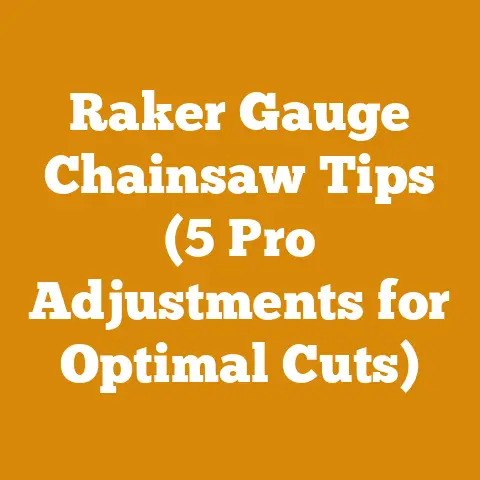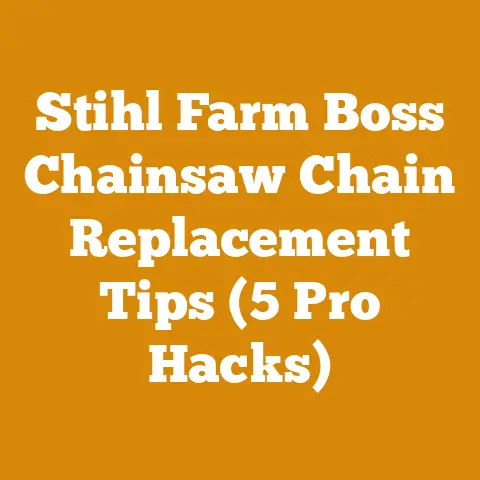How to Quote a Fence Job (5 Pro Tips for Accurate Wood Pricing)
As someone who’s spent countless hours in the field, felling trees, milling lumber, and preparing firewood, I understand the importance of safety when working with wood.
Before we dive into the nitty-gritty of quoting a fence job, let’s take a moment to emphasize the critical role safety plays in every step of the process.
Safety First: A Personal Anecdote
I’ll never forget the day I saw a seasoned logger take a shortcut while felling a large oak.
He was so focused on speed that he neglected to properly assess the lean of the tree and the surrounding environment.
The oak fell unpredictably, narrowly missing him but causing significant damage to nearby equipment.
That incident served as a stark reminder that complacency is the enemy of safety.
Essential Safety Gear
Eye Protection: Safety glasses or a face shield are non-negotiable.
Debris from cutting, splitting, and sanding can cause serious eye injuries.Hearing Protection: Chainsaws and other power tools generate significant noise.
Earplugs or earmuffs are essential to prevent long-term hearing damage.Hand Protection: Gloves protect your hands from cuts, splinters, and abrasions.
Choose gloves that provide a good grip and allow for dexterity.Foot Protection: Steel-toed boots are a must.
They protect your feet from falling objects and provide a stable platform for working.Leg Protection: Chainsaw chaps are crucial when operating a chainsaw.
They’re designed to stop the chain instantly, preventing severe injuries.-
Head Protection: A hard hat is essential, especially when felling trees or working in areas where falling objects are a risk.
Safe Work Practices
Inspect Tools: Before each use, thoroughly inspect your tools for damage.
Ensure that blades are sharp, handles are secure, and safety features are functioning correctly.Clear the Work Area: Remove any obstacles that could cause you to trip or lose your balance.
Ensure that bystanders are a safe distance away.Use Proper Techniques: Learn and practice the correct techniques for each task.
This will not only improve your efficiency but also reduce the risk of injury.Take Breaks: Woodworking can be physically demanding.
Take regular breaks to avoid fatigue, which can lead to errors and accidents.Stay Alert: Pay attention to your surroundings and be aware of potential hazards.
Avoid distractions and never work under the influence of alcohol or drugs.
Now that we’ve covered the importance of safety, let’s move on to the main topic: how to quote a fence job.
How to Quote a Fence Job (5 Pro Tips for Accurate Wood Pricing)
Quoting a fence job accurately is crucial for ensuring profitability and customer satisfaction.
As someone who’s been building fences for years, I’ve learned that a well-prepared quote not only helps you win the job but also sets clear expectations with your client.
In this article, I’ll share five pro tips for accurately pricing wood for fence projects, drawing on my own experiences and industry best practices.
1. Detailed Material Estimation: Know Your Wood Inside and Out
The foundation of any accurate quote is a thorough material estimation.
This involves not just knowing the quantity of wood you’ll need, but also understanding the specific types, dimensions, and grades required for the project.
Wood Anatomy and Properties: A Quick Refresher
Before we dive into the specifics of material estimation, let’s briefly review the anatomy and properties of wood.
Understanding these factors is essential for selecting the right wood for the job and accurately predicting its performance.
Hardwood vs.
Softwood: Hardwoods come from deciduous trees (trees that lose their leaves annually), while softwoods come from coniferous trees (trees that have needles and cones).
Hardwoods are generally denser and more durable than softwoods, but they are also more expensive and can be more difficult to work with.- Example: Oak (hardwood) is a popular choice for fence posts due to its strength and resistance to decay.
Pine (softwood) is often used for fence pickets due to its affordability and ease of installation. -
Grain: The grain of wood refers to the arrangement of its fibers.
Straight-grained wood is easier to work with and less prone to warping than wood with irregular grain patterns. -
Example: Cedar, known for its straight grain, is a favorite for fencing because it stays true and resists twisting.
-
Moisture Content: The moisture content of wood affects its weight, strength, and stability.
Wood shrinks as it dries, so it’s important to use wood that has been properly seasoned (dried) to minimize warping and cracking. -
Industry Statistic: According to the Forest Products Laboratory, wood shrinks approximately 1% for every 4% change in moisture content below the fiber saturation point (around 30%).
-
Durability: Some wood species are naturally more resistant to decay and insect damage than others.
This is due to the presence of natural oils and extractives that act as preservatives. -
Data Point: Redwood and cedar contain natural compounds that make them highly resistant to rot, making them ideal for outdoor applications like fencing.
- Fence Length and Height: These measurements determine the total amount of lumber required for posts, rails, and pickets.
- Post Spacing: The distance between posts affects the number of posts needed.
A common spacing is 8 feet, but this may vary depending on the design and local building codes. - Picket Style and Spacing: The width and spacing of pickets influence the amount of lumber required.
A closer spacing will require more pickets. - Gate Specifications: Don’t forget to include materials for gates, such as gate posts, hinges, latches, and gate framing lumber.
Once I have these measurements, I use a spreadsheet to calculate the required quantities of each material.
Here’s an example:Material Dimensions Quantity Unit Price per Unit Total Price 4×4 Posts 8 ft 20 Each \$15 \$300 2×4 Rails 16 ft 30 Each \$8 \$240 1×6 Pickets 6 ft 200 Each \$3 \$600 Concrete Mix 80 lb bag 10 Each \$5 \$50 Fasteners Various 1 Box \$25 \$25 Gate Hardware Hinge/Latch Set 1 Set \$30 \$30 Subtotal \$1245 Contingency (10%) \$124.50 Total Material Cost \$1369.50 Accounting for Waste
It’s crucial to add a contingency for waste.
Wood is a natural material, and there will inevitably be some waste due to cuts, knots, and imperfections.
I typically add 10% to the total lumber quantity to account for waste.Sourcing Materials and Obtaining Quotes
Once you have a detailed material list, it’s time to source your materials and obtain quotes from suppliers.
I recommend getting quotes from multiple suppliers to ensure you’re getting the best price.- Local Lumberyards: Local lumberyards often offer competitive pricing and personalized service.
They may also be willing to negotiate prices, especially if you’re a regular customer. - Big Box Stores: Big box stores like Home Depot and Lowe’s can be convenient, but their prices may not always be the lowest.
However, they often have sales and promotions that can save you money. - Online Retailers: Online retailers can be a good option for specialty items or hard-to-find materials.
However, be sure to factor in shipping costs when comparing prices.
When obtaining quotes, be sure to specify the grade and quality of the wood you need.
For example, you might specify “premium grade cedar” or “construction grade pine.” This will help ensure that you’re comparing apples to apples.2.
Labor Costs: Valuing Your Time and ExpertiseLabor costs are a significant component of any fence job quote.
Accurately estimating labor requires a clear understanding of the project scope, the complexity of the design, and your own efficiency.Breaking Down the Project into Tasks
To estimate labor costs accurately, I break down the project into individual tasks, such as:
- Site Preparation: This includes clearing the area, removing existing structures, and leveling the ground.
- Post Installation: This involves digging post holes, setting posts, and pouring concrete.
- Rail Installation: This includes cutting and attaching rails to the posts.
- Picket Installation: This involves cutting and attaching pickets to the rails.
- Gate Installation: This includes assembling and installing the gate, as well as installing hardware.
- Cleanup: This involves removing debris and leaving the site in a clean and orderly condition.
Estimating Time per Task
Once I’ve broken down the project into tasks, I estimate the amount of time required to complete each task.
This is where experience comes in handy.
Over time, you’ll develop a sense of how long it takes to complete various tasks.- Example: Setting a post, including digging the hole and pouring concrete, might take 1-2 hours per post, depending on soil conditions and the size of the post.
To improve your accuracy, I recommend tracking your time on past projects.
This will give you valuable data to use when estimating future jobs.Calculating Labor Rate
Your labor rate should reflect your experience, skill level, and overhead costs.
Overhead costs include things like insurance, vehicle expenses, and tool maintenance.- Industry Standard: According to industry surveys, the average hourly rate for fence installers ranges from \$30 to \$75, depending on location and experience.
To determine your labor rate, I recommend calculating your total overhead costs and dividing that by the number of hours you expect to work per year.
Then, add a profit margin to arrive at your hourly rate.- Example: If your annual overhead costs are \$10,000 and you expect to work 2,000 hours per year, your overhead cost per hour is \$5.
If you want to earn a profit of \$20 per hour, your labor rate should be \$25 per hour.
Factoring in Complexity and Difficulty
Some fence projects are more complex and difficult than others.
For example, a fence on a steep slope or with intricate design details will require more time and effort.
Be sure to factor in these factors when estimating labor costs.- Tip: Add a contingency to your labor estimate to account for unforeseen challenges.
I typically add 10-15% to my labor estimate for this purpose.
3.
Overhead and Profit: The Foundation of a Sustainable BusinessOverhead and profit are essential components of any fence job quote.
Overhead covers your business expenses, while profit ensures that you’re compensated for your risk and effort.Understanding Overhead Costs
Overhead costs are the expenses you incur to run your business, regardless of whether you’re working on a specific project.
These costs can include:- Insurance: Liability insurance, workers’ compensation insurance, and vehicle insurance.
- Vehicle Expenses: Fuel, maintenance, and depreciation.
- Tool Maintenance: Repairs, replacements, and sharpening.
- Office Expenses: Rent, utilities, and supplies.
- Marketing Expenses: Advertising, website maintenance, and business cards.
To accurately account for overhead costs, I recommend tracking all of your business expenses and allocating them to individual projects.
This can be done using accounting software or a simple spreadsheet.Calculating Profit Margin
Profit margin is the percentage of revenue that remains after paying all expenses, including materials, labor, and overhead.
Your profit margin should be high enough to compensate you for your risk and effort, as well as to allow you to reinvest in your business.- Industry Standard: The average profit margin for fence contractors ranges from 10% to 20%.
To determine your profit margin, consider the following factors:
- Competition: If you’re in a highly competitive market, you may need to accept a lower profit margin to win jobs.
- Risk: If the project is particularly risky or complex, you may need to charge a higher profit margin to compensate for the added risk.
- Value: If you offer a unique service or expertise, you may be able to charge a higher profit margin.
Presenting Overhead and Profit in Your Quote
When presenting your quote to the client, it’s important to be transparent about your overhead and profit.
This will help them understand the value of your services and why your price is justified.Essential Contract Elements
Every fence job contract should include the following elements:
- Project Description: A detailed description of the work to be performed, including the type of fence, dimensions, and materials.
- Payment Terms: A clear statement of the total price, payment schedule, and accepted methods of payment.
- Start and Completion Dates: Estimated start and completion dates for the project.
- Change Order Procedure: A procedure for handling changes to the scope of work, including how changes will be documented and priced.
- Warranty: A description of any warranties offered on materials or workmanship.
- Liability: A statement of your liability for damages or injuries that may occur during the project.
- Termination Clause: A clause outlining the conditions under which either party can terminate the contract.
- Signatures: Signatures of both the contractor and the client, indicating their agreement to the terms of the contract.
Using Clear and Concise Language
When writing your contract, it’s important to use clear and concise language that is easy for the client to understand.
Avoid jargon and technical terms that may be confusing.- Tip: Have a lawyer review your contract to ensure that it is legally sound and protects your interests.
Addressing Potential Issues Upfront
A good contract addresses potential issues upfront, such as:
- Permits: Who is responsible for obtaining any necessary permits?
- Underground Utilities: What happens if underground utilities are encountered during excavation?
- Property Lines: How will property lines be determined?
- Weather Delays: How will weather delays be handled?
By addressing these issues upfront, you can minimize the risk of disputes and ensure that the project runs smoothly.
5.
Communication and Follow-Up: Building Trust and Securing the JobEffective communication and follow-up are essential for building trust with potential clients and securing the job.
Clients want to feel confident that you’re reliable, professional, and committed to delivering a high-quality product.Prompt and Professional Responses
Respond to inquiries promptly and professionally.
This shows the client that you value their business and are eager to help them.- Tip: Set up an email auto-responder to acknowledge receipt of inquiries and provide an estimated response time.
Active Listening and Needs Assessment
When meeting with a potential client, take the time to listen to their needs and concerns.
Ask questions to clarify their vision for the project and identify any potential challenges.- Example: “What are your primary goals for the fence?
Are you looking for privacy, security, or aesthetics?”
Providing Detailed and Transparent Quotes
Provide a detailed and transparent quote that clearly outlines the scope of work, materials, and costs.
Be prepared to answer any questions the client may have about the quote.- Tip: Offer multiple options or packages to cater to different budgets and preferences.
Following Up After the Quote
Follow up with the client after submitting the quote to answer any questions and address any concerns.
This shows that you’re proactive and committed to earning their business.- Tip: Send a thank-you note or email after the initial meeting to express your appreciation for their time.
Building Long-Term Relationships
Building long-term relationships with clients can lead to repeat business and referrals.
Treat every client with respect and strive to exceed their expectations.- Tip: Stay in touch with past clients by sending holiday cards or newsletters.
Real-World Examples
To illustrate these pro tips, let’s look at a few real-world examples.
Case Study 1: The Privacy Fence Project
I was asked to quote a privacy fence project for a homeowner who wanted to create a secluded backyard space.
The homeowner had a specific vision for the fence, including a custom gate and decorative post caps.The Challenge
The challenge was to accurately estimate the cost of the custom gate and decorative post caps, as these items were not standard and required additional research and sourcing.
The Solution
I contacted several suppliers to obtain quotes for the custom gate and decorative post caps.
I also factored in the additional labor required to install these items.Case Study 2: The Sloping Yard Fence
I was asked to quote a fence project for a homeowner whose yard had a significant slope.
This presented several challenges, including the need to adjust post heights and ensure that the fence followed the contour of the land.The Challenge
The challenge was to accurately estimate the additional labor required to install the fence on a sloping yard.
The Solution
I carefully assessed the slope of the yard and factored in the additional time required to adjust post heights and ensure that the fence followed the contour of the land.
I also added a contingency to my labor estimate to account for any unforeseen challenges.The Result
By accurately estimating the additional labor required for the sloping yard, I was able to provide the homeowner with a fair and competitive quote.
The homeowner appreciated my honesty and transparency and awarded me the job.Additional Tips and Considerations
Here are some additional tips and considerations to keep in mind when quoting a fence job:
- Local Building Codes: Be sure to familiarize yourself with local building codes and regulations.
This will help you avoid costly mistakes and ensure that the fence is built to code. - Underground Utilities: Contact your local utility companies to locate any underground utilities before digging post holes.
This will prevent damage to utilities and ensure your safety. - Property Lines: Verify property lines with the homeowner before starting the project.
This will prevent disputes with neighbors and ensure that the fence is built in the correct location. - Weather Conditions: Be aware of weather conditions and plan accordingly.
Extreme heat, cold, or rain can affect your productivity and safety. - Tool Maintenance: Keep your tools in good working order.
Sharp blades and well-maintained equipment will improve your efficiency and safety. - Insurance Coverage: Ensure that you have adequate insurance coverage to protect yourself and your business.
Final Thoughts
Quoting a fence job accurately requires attention to detail, a thorough understanding of materials and labor, and effective communication with clients.
By following these pro tips, you can increase your chances of winning jobs, ensuring profitability, and building long-term relationships with satisfied customers.
Remember, a well-prepared quote is not just about the numbers; it’s about building trust and setting clear expectations.
- Example: Oak (hardwood) is a popular choice for fence posts due to its strength and resistance to decay.






